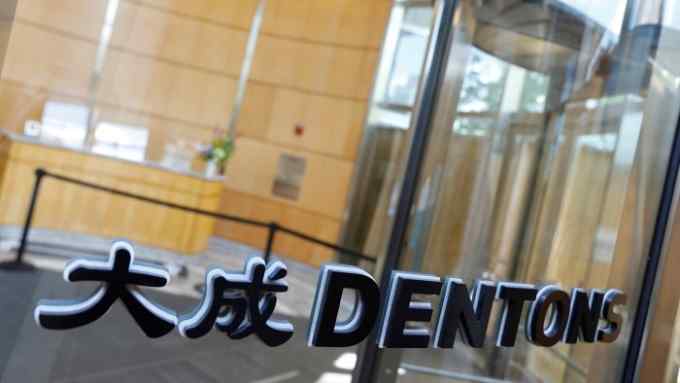Agility will be vital post-pandemic, say lawyers

Roula Khalaf, Editor of the FT, selects her favourite stories in this weekly newsletter.
If law firms return to pre-2020 “normal”, they will be missing a trick, reckons Elliott Portnoy, the global chief executive of law firm Dentons.
“Firms that focus on how soon they can get everyone back to their offices will miss the opportunity to drive permanent change in the way they work and service clients,” explains Portnoy, who is based in Washington DC.
He believes an agile approach will be an imperative for all firms, even when the pandemic subsides. Clients will expect more flexibility in an ever-changing world, he says, and law firms must rethink their services to meet these needs.
In 2019, Dentons began developing a toolkit to improve agile working across its offices worldwide. That model was tested to the extreme later that year when Covid-19 hit Wuhan, where the firm has an office.
“Remote working had to start immediately,” says Portnoy. “Having policies, guidance and a framework in place to promote agility has been hugely impactful. We’ve discovered that, in some regions, we can meet client needs across each step of the lifecycle, without the need for a physical footprint.”
Recently, Dentons closed two of its UK physical offices, in Watford and Aberdeen, as they were no longer deemed necessary — but retained all its staff at those locations.
For Elizabeth Reza, a partner in Ropes & Gray’s asset management group in Boston, to be “agile” means being able to work “wherever you need to be”. Reza says this means having the right tools in place and a culture that helps lawyers service clients no matter where they are — while also giving them space to work around personal commitments.
Ropes & Gray has operated a flexible working policy — letting lawyers work remotely, or reduce their hours or modify schedules — for more than a decade, and its practice areas already worked across multiple offices globally. This made the transition to working under lockdown easier, says Reza.
“Even before the pandemic, we worked on a daily basis with teammates across the country and around the world who we couldn’t see all the time,” says Reza.
Chicago-based Mary Wilson, managing partner of Dentons’ US operations, credits much of the firm’s agility during the pandemic to its IT team, paralegals and professional colleagues who helped pivot the firm to full remote working early in 2020.
“Once we proved we could work effectively from home, we went about working out how to make it as successful as possible to respond to client needs,” says Wilson. “There was a big focus on professional development — particularly upskilling around technology usage and familiarity with digital tools like video conferencing, document sharing, electronic billing and daily time entry.”
Portnoy says he and his colleagues are more connected now than they were before the pandemic: “Bringing a much broader group of colleagues together — not just lawyers but also business and professional services team members — improves the business.”
At Ropes, a secure VPN, virtual desktops and widespread laptop usage made the transition to homeworking safe, secure and productive. But Reza says the most helpful tool was Zoom, which made meetings more inclusive.

“It gives everyone the ability to be part of the discussion, as opposed to having 10 people in a conference room in Boston, with perhaps a few from Chicago and San Francisco piped in on a video screen,” she says.
Another Ropes & Gray partner in Boston, Amanda Austin, believes the firm became more agile by bringing junior and more experienced lawyers together online.
“Since we weren’t going to bump into each other in the hallway or pop into each other’s offices, we made a concerted effort to put regular and meaningful time on the schedule for colleagues of all experience levels to talk via video conferencing,” says Austin. “We have been able to spend more time face-to-face than we might otherwise — even in person.”
Lawyers admit some team members take to the concept of agile working better than others. Firms still need comprehensive technology training and support to assist those who are less tech-savvy.
Austin says Ropes’ more junior associates have often been quick to find tech shortcuts and help senior colleagues become more efficient.
One simple but effective tool for Dentons has been screen-sharing, to collaboratively draft legal documents. “It lets everyone in the group contribute ideas and helps less experienced lawyers learn in real time from their peers and more senior colleagues,” says Wilson.
For Portnoy, collaborative working also provides a way for all colleagues — not just lawyers — at the firm to have greater input. “Cross disciplinary teams prove to be far more innovative,” he says.
Agile working gives Dentons colleagues greater visibility, regardless of their location, adds Wilson. On phone calls with clients, for example, colleagues and associates would have joined partners, but only in the background and not “visible”, she explains. “The way we’re using technology now gives them a seat at the table.”
Wilson says such technology also makes the firm far more agile when it comes to servicing clients: “If you were flying to a client meeting across the country or the world, you might only take a few key people. But, now, we can put far more talent in front of clients, wherever they’re located.”
Using lawyers across multiple time zones also means you can provide clients with access to talent around the clock, she adds. “Geographies become immaterial.”
Jonathan Brayne: Agility is so more than mobile working
Until recently, Jonathan Brayne thinks lawyers regarded agility as just one thing: mobile working. Yet the Allen & Overy partner says it has become much more: “It’s the use of technology, processes, working practices, and data in new ways to meet client needs.”
Brayne is also chair of Fuse, A&O’s start-up incubator, in which lawyers can collaborate with clients and use tech to solve practical problems, such as automating high volume or routine contracts.
“If you can help clients contract with their customers in two weeks instead of two months, then revenues from the deal will come in much faster,” says Brayne, who is based in London.
He adds that developing self-serve legal solutions, on a platform supplied by the law firm, is another example of agility — as it removes the need to engage with an external or in-house lawyer for every transaction.
Technology also allows firms to train new lawyers effectively, without being in a physical office.
Jeremy Ng is a trainee solicitor at Allen & Overy who started his traineeship before the pandemic. Ng says trainees broadly do two different types of work: high-level legal tasks such as drafting court submissions and conducting research and analysis; and process management, such as collecting signature pages and managing transactions.
He has found that, with adept use of technology and commitment from senior lawyers to training, high-level legal tasks can be learned easily in a virtual environment.
Process management, however, requires learning by example and emulating best practices. To substitute this virtually, the trainees at A&O have used video calls and informal chats to share insights, often facilitated by trainee-led working groups.
Ng says working from home gives younger lawyers the flexibility to choose the way they engage with people.
“If you’re in the office, you’re subjected to other people’s preferred mode of communication,” Ng says. “Whereas working remotely, everyone has the same set of tools and you have more flexibility to deploy them in the way that you like.”

Comments